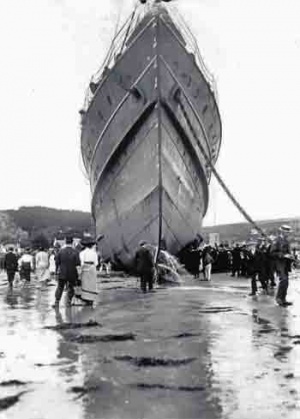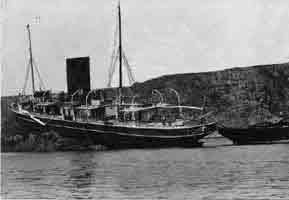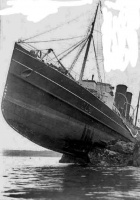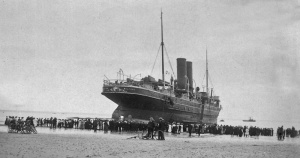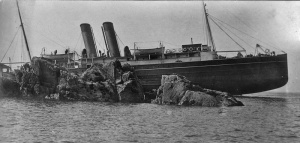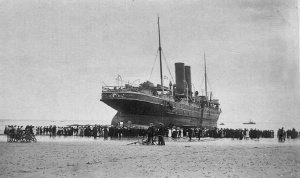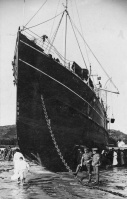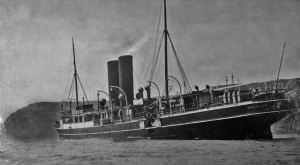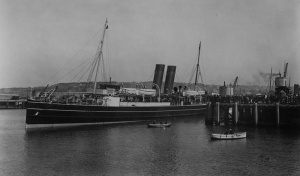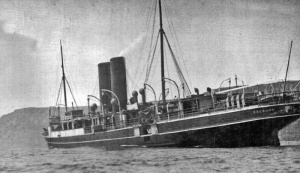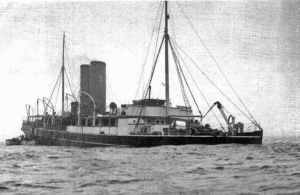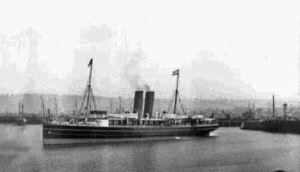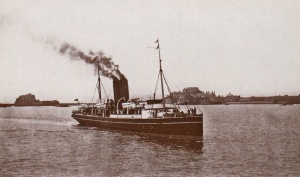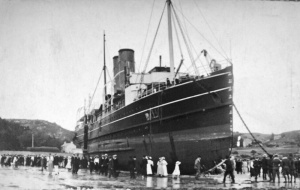Roebuck

Shipwreck: ss Roebuck
|
On 19 July 1911 the Great Western Railway steamer Roebuck, which had been on the Channel Islands route for 14 years, left St Helier Harbour for Guernsey on what should have been a routine voyage.
Calm conditions
There was no wind, the sea was calm, but there was a thick sea mist and after rounding Noirmont Point, the ship, with experienced Captain John Le Feuvre at the helm, struck the Kaines rocks off Fliquet Bay, between St Brelade's Bay and Corbiere.
Capt Le Feuvre had miscalculated his position and maintained a speed of 17 knots despite the visibility. His crew lookout spotted swirling water which was the tell-tale sign of submerged rocks, but he turned too late towards open sea and the ship struck the rocks and stayed there, 200 of its 280 feet firmly stuck to the reef, and a 100 foot gash in its side.
Shore out of sight
The shore was less than 300 metres away, but out of sight in the dense mist. Distress flares were let off and the ship's lifeboats were launched and soon joined by the lifeboat and States tug Duke of Normandy from St Helier. Within an hour all the passengers were safely ashore and so calm was the sea that the Duke of Normandy went alongside the stricken Roebuck to take off the passengers' luggage.
A further 20 tons of cargo were taken off the ship, which remaind stuck fast on the Kaines for eight days. The ship was a sensation for locals, who flocked to see it. Vain attempts were made for four salvage vessels to pull it clear of the rocks on high tides from 21 to 23 July, but a pinnacle of rock was penetrating the hull and making it impossible to move.
Beached in St Brelade's Bay
Temporary repairs were made to the hull with wood and cement to allow it to float higher and on 28 July it was finally moved to a safer position on the sands of St Brelade's Bay, enabling curious residents to walk around the massive hull at low tide and have some amazing souvenir photographs taken, many of which survive to this day.
Further repairs were made but on the first attempt to tow the Roebuck back to St Helier she took on too much water and had to be beached in Belcroute Bay. It was not until the middle of August that she reached St Helier Harbour, eventually to be towed to Southampton for permanent repairs.
After a Board of Trade inquiry Capt Le Feuvre's master's ticket was suspended for only three months, despite this being the second time that a Great Western steamer under his command, had hit rocks off Jersey's south coast. Fourteen years earlier he lost his ticket for six months after the Ibex, which had apparently been racing a rival vessel, hit a rock off Corbiere.
The Roebuck returned to the Channel Islands route in 1912 and was then recquisitioned by the Navy in 1914, and renamed HMS Roedean. She sank a year later in 15 fathoms of water at Scapa Flow, after dragging her anchor.
Newspaper report
This information is drawn from an article published in the Jersey Evening Post in 2018, itself based on the newspaper's contemporaneous reporting of the shipwreck
The sight of the Great Western Railway Company's magnificent steamer, the Roebuck, wedged on a reef off Jersey's south coast whipped the island into a frenzy.
Thousands went to see it, either on foot, by bicycle, horse-drawn carriage or car. Within just a few days Jersey Railway estimated that it had taken at least 3,000 passengers to La Moye or Don Bridge stations to behold the sight.
On one afternoon alone 2,000 people were counted on the headland above Beauport. The small steamship Courier began running 'Roebuck Excursions', and the owner of the Alhambra cinema took himself off to the scene, filmed the vessel, and showed the footage at a charge to all those who were unable to get themselves to St Brelade.
It was an incredible sight, talked up by all who had seen it. Even the Evening Post was seemingly swept away with the hysteria, writing:'There she lies like a great stricken colossus.'
The Roebuck inadvertently ended up becoming the island's star attraction on 19 July 1911, shortly after leaving Jersey for Weymouth, via Guernsey, when, in thick fog, she crashed into the Kaines rocks, 300 yards from the shore near St Brelade's Bay.
The 280-foot vessel was carrying 260 passengers and 44 crew, as well as 20 tons of cargo. Many of the passengers were tourists returning home to England or on a day trip to Guernsey.
Departing St Helier in calm conditions but poor visibility, Captain John Le Feuve set the ship at 17 knots. The fog momentarily lifted, giving the passengers and crew a glimpse of rocks that were closer than many had expected, before the visibility once again reduced.
From the bridge swirling water could be seen a short distance ahead - a sign of rocks - and although the captain ordered an immediate turn to port, moments later there was a violent shock, a long scraping sound and the ship heeled over to starboard and shuddered to a halt, wedged on a substantial rock.
Although badly holed, the ship was stuck fast and in little danger of becoming fully submerged.

The Evening Post quickly dispatched a reporter to St Brelade's Bay by car. He chartered a rowing boat to the scene and penned a detailed description of the ship and the frenzy of excitement which surrounded its predicament.
Under the headline 'The perils of fog at sea' the paper reported:
- "Great excitement prevailed early this morning, not only in St Helier but throughout the island, when it became known that the Great Western steamer Roebuck had struck a group of rocks known as the Kaines.
- "The Roebuck presented a pitiable sight, Her deck near the bows was almost level with the water's edge, and she gave the impression of being a total wreck. On board the scene was one of desolation."
The passengers, all of whom were unharmed, were taken ashore and back to St Helier in a procession of horse-drawn carriages.
Passenger Mr S Leary, of Bristol, said:
- "I was talking to a friend on deck when, all of a sudden, and before you could say 'Jack Robinson', there was a terrific jar, which shook the vessel from stem to stern. She seemed to crash over one rock to another.
- "There was no panic, and I cannot speak too highly of the courage displayed by the ladies."
Other passengers reported that the fog thickened after Noirmont Point and large rocks could be seen on the starboard side, before the vessel crashed into rocks ahead.
Harry Eccles, from London, said:
- "There was absolutely no panic, although it took some 18 minutes to get the boats out. The officers and crew behaved very calmly, particularly chief officer Mr Allen, who displayed great coolness in the work to disembark 200 passengers. The experience is one which I shall never forget."
After being patched up and pumped out, attempts to refloat the Roebuck on 21, 22 and 23 July failed. On 28 July, with crowds at every viewpoint from La Moye to Ouaisne, and both the Bailiff and Lieut-Governor watching, the ship was towed, largely submerged, to the beach in St Brelade's Bay.
This heightened the hysteria and queues had to be organised to allow everyone to walk safely past the ship, which still had some of the Kaines rocks inside it.
On 14 August another bid was made to bring the vessel back to St Helier, but the first attempt failed and the Roebuck was beached at Belcroute.
Later that day it arrived back at the town harbour and was eventually taken to Southampton for repairs. An inquiry found that Captain le Feuvre had not followed the proper course and that the vessel was travelling too fast in the poor visibility.
After taking into his account his unblemished career, his master's certificate was suspended for three months.
The Roebuck returned to service in January of the following year. At the start of the Great War she was commandeered by the Royal Navy and renamed HMS Roedean. On 13 January 1915 she became the first railway ship to be lost in war service when she sank off the Orkney Islands after dragging her anchor and hitting another vessel. No efforts were made to raise her.
Gallery
Roebuck dressed overall, probably on her maiden voyage to Jersey, photographed by Philip Morel-Laurens
